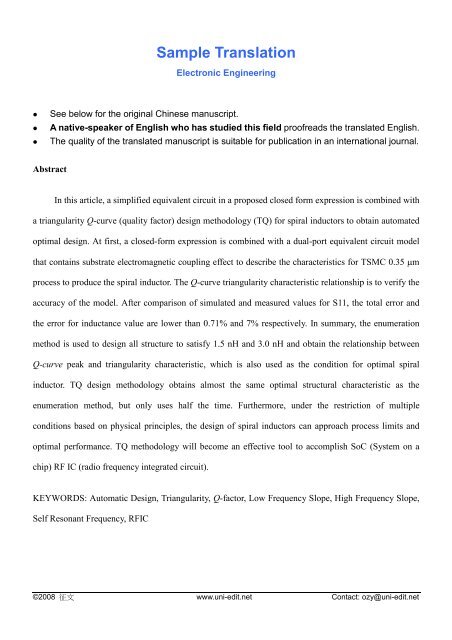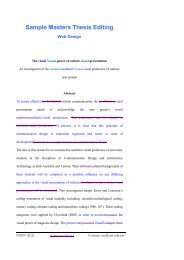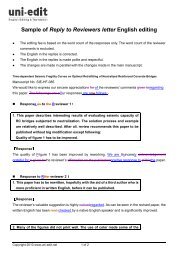Sample Translation - Uni-edit
Sample Translation - Uni-edit
Sample Translation - Uni-edit
Create successful ePaper yourself
Turn your PDF publications into a flip-book with our unique Google optimized e-Paper software.
<strong>Sample</strong> <strong>Translation</strong><br />
Electronic Engineering<br />
<br />
<br />
<br />
See below for the original Chinese manuscript.<br />
A native-speaker of English who has studied this field proofreads the translated English.<br />
The quality of the translated manuscript is suitable for publication in an international journal.<br />
Abstract<br />
In this article, a simplified equivalent circuit in a proposed closed form expression is combined with<br />
a triangularity Q-curve (quality factor) design methodology (TQ) for spiral inductors to obtain automated<br />
optimal design. At first, a closed-form expression is combined with a dual-port equivalent circuit model<br />
that contains substrate electromagnetic coupling effect to describe the characteristics for TSMC 0.35 µm<br />
process to produce the spiral inductor. The Q-curve triangularity characteristic relationship is to verify the<br />
accuracy of the model. After comparison of simulated and measured values for S11, the total error and<br />
the error for inductance value are lower than 0.71% and 7% respectively. In summary, the enumeration<br />
method is used to design all structure to satisfy 1.5 nH and 3.0 nH and obtain the relationship between<br />
Q-curve peak and triangularity characteristic, which is also used as the condition for optimal spiral<br />
inductor. TQ design methodology obtains almost the same optimal structural characteristic as the<br />
enumeration method, but only uses half the time. Furthermore, under the restriction of multiple<br />
conditions based on physical principles, the design of spiral inductors can approach process limits and<br />
optimal performance. TQ methodology will become an effective tool to accomplish SoC (System on a<br />
chip) RF IC (radio frequency integrated circuit).<br />
KEYWORDS: Automatic Design, Triangularity, Q-factor, Low Frequency Slope, High Frequency Slope,<br />
Self Resonant Frequency, RFIC<br />
©2008 征 文 www.uni-<strong>edit</strong>.net Contact: ozy@uni-<strong>edit</strong>.net
I. Introduction<br />
While pursuing the wireless communication market development, the use of low-cost and<br />
high-performance CMOS (complementary metal oxide semiconductor) technology is the common<br />
solution to create system on chip (SoC) technologies [1]. However, the progress of SoC radio frequency<br />
(RF) integrated circuits (IC) is dependent on the design efficiency and automation of integrated spiral<br />
inductors. In addition, to satisfy the requirement of an accurate inductance value is also a key point for<br />
present design.<br />
Spiral inductors are produced on silicon chips to meet the inductance requirement of RF IC. With the<br />
assistance of electromagnetic simulation software, the design method [2] needs to calibrate the simulation<br />
environment as well as geometrical dimensions to obtain a spiral inductor structure that can meet the<br />
circuit requirements. This is a time-consuming and ineffective design method whereby the mass<br />
production of a testkey inductor database is established [3]. This not only expensive but also fails to meet<br />
circuit requirements. Developing closed form expressions for the physical structure of scalable silicon<br />
spiral inductors to find a design method that meets requirements can be divided into two classes: one is<br />
the equation developed on geometrical structural dimensions or based on the concepts of electromagnetic<br />
physics, using a massive amount of testkeys to obtain empirical formula for curve fitting [4-5]; the other<br />
is to use electromagnetic physics-based algorithms [6-9]. Although the empirical formula for curve fitting<br />
has a very simple correlation that is suitable for automatic design applications, it has to use a massive<br />
amount of curve fitting parameters and therefore it results in insufficient accuracy for calculations. The<br />
algorithm proposed by Greenhouse in 1974 has sufficient accuracy and scalability. However, the<br />
calculation process is too complicated and not suitable for automatic design.<br />
©2008 征 文 www.uni-<strong>edit</strong>.net Contact: ozy@uni-<strong>edit</strong>.net
Abstract<br />
本 论 文 , 提 出 以 具 体 的 解 析 式 (closed form expression) 的 简 化 等 效頒 电 路 模 型 , 结 合 螺 旋 电 感 的 Q<br />
值 (quality factor) 曲 线 三 角 形 特顠 征 的 设 计 法 (triangularity Q-curve design methodology, TQ), 获 得 集<br />
成 螺 旋 电 感 的 最 优 化 自 动 设 计 。 首靫 先 采 用 具 体 的 解 析 式 (closed-form expression) 结 合 包 含 基 底 电 磁<br />
耦 合 效頒 应 的 双 埠 形 等 效頒 电 路 模 型 , 描 述 TSMC 0.35μm 制 作 螺 旋 电 感 过 程 的 特顠 性 。 通 过 Q 值 曲 线 三<br />
角 形 特顠 征 关 系 验 证 模 型 的 准鞔 确 度 。 通 过 比 较 仿 真 值 与 测 量 值 ,S11 的 总 误 差韤 (totalµ0.35 error) 与 电 感<br />
值靹 的 误 差韤 都 分 别 低 于 0.71% 和 7%。 总 而 言 之 , 以 列 举 法 (enumeration) 设 计 满 足 1.5 nH 及 3.0 nH 的 所<br />
有 结 构 , 获 得 Q 值 曲 线 顶 峰韠 与 三 角 形 特顠 征 的 特顠 殊頻 关 系 , 并 作 为 最 优 化 螺 旋 电 感 特顠 性 的 限 制 条 件 。 TQ<br />
设 计 法 获 得 的 最 优 化 结 构 特顠 性 与 列 举 法 几 乎 一 样 , 但 是 时 间 却 减 少 了 一 半 。 此 外 , 在 基 于 物 理 基<br />
础 的 多 目 标 条 件 的 限 制 下 , 设 计 的 螺 旋 电 感 特顠 性 可 接 近 制 作 过 程 极 限 并 达 到 最 优 化 要 求 。TQ 法 将<br />
成 为 实 现 单 晶 片 (System on a chip, SoC) 射韗 频 集 成 电 路 (radio frequency integrated circuit, RFIC) 的 利<br />
器 。<br />
KEYWORDS: Automatic Design, Triangularity, Q-factor, Low Frequency Slope, High Frequency Slope,<br />
Self Resonant Frequency, RFIC<br />
I. Introduction<br />
针 对 无 线 通 讯 市 场 发 展韙 , 应 用 低 价 高 效頒 的 CMOS (complementary metal oxide semiconductor) 技<br />
术 , 被 公 认 为 实 现 单 晶 片 的 解 决 方 案頥 [1]; 然 而 , 单 晶 片 射韗 频 集 成 电 路 的 研 发 速 度 受 制 于 集 成 化 螺<br />
旋 电 感 (integrated spiral inductor) 的 设 计 的 效 率 和 设 计 的 自 动 化 程 度 。 高 品 质 因 子 平 面 螺 旋 电 感 的<br />
自 动 化 设 计 开 发 , 是 一 项 对 于 系 统 单 晶 片 的 发 展韙 而 言 非 常 地 重 要 的 技 术 , 在 满 足 电 路 需 求 的 准鞔 确<br />
感 值靹 的 同 时 , 迎 合 电 路 应 用 需 求 频 段 的 最 佳 效頒 能 , 也 是 目 前 设 计 的 重 点 之 一 。<br />
在 硅 晶 片 上 制 作 符 合 射韗 频 积 体 电 路 需 求 感 值靹 的 螺 旋 电 感 , 通 过 电 磁 模 拟 软 件 协 助 的 设 计 方 式 [2],<br />
除 了 需 要 校頣 正 仿 真 环 境 之 外 , 也 必 须 一 再 地 调 校頣 几 何 尺 寸 , 以 获 得 满 足 电 路 需 求 的 螺 旋 电 感 结 构 。<br />
这 是 一 种 既 费 时 又 低 效頒 的 设 计 方 法 ; 藉 由 大 量 制 作 测 试 键 以 建 立 电 感 元 件 资 料頔 库 [3], 除 了 花 费 不<br />
菲 外 , 同 时 也 无 法 准鞔 确 满 足 电 路 之 需 求 ; 发 展韙 可 调 节 的 ( scalable) 硅 基 螺 旋 电 感 的 物 理 结 构 的 具 体<br />
©2008 征 文 www.uni-<strong>edit</strong>.net Contact: ozy@uni-<strong>edit</strong>.net
的 解 析 式 , 以 获 得 满 足 需 求 的 设 计 方 式 , 又 分 类 成 二 大 类 : 一 是 以 几 何 结 构 尺 寸 或 基 于 电 磁 物 理<br />
理 论 所 发 展韙 的 方 程 式 , 透 过 大 量 测 试 键 (testkeys) 获 得 拟 合 的 (curve fitting) 经 验 方 程 式 (empirical<br />
formula) [4-5]; 另 一 是 运 用 电 磁 物 理 为 基 础 的 算 法 (physics-based algorithms) [6-9]。 虽 然 拟 合 的 经 验<br />
方 程 式 具 有 非 常 简 洁 的 关 系 式 , 适 合 自 动 设 计 的 应 用 , 但 却 必 须 引 用 大 量 拟 合 参 数 , 导 致 计 算 的<br />
准鞔 确 度 不 足 ; 而 Greenhouse 在 1974 提 出 的 算 法 虽 然 具 有 足 够 的 准鞔 确 度 及 可 调 节 性 , 但 计 算 过 程<br />
过 于 复 杂 , 并 不 适 合 自 动 化 设 计 。<br />
©2008 征 文 www.uni-<strong>edit</strong>.net Contact: ozy@uni-<strong>edit</strong>.net







